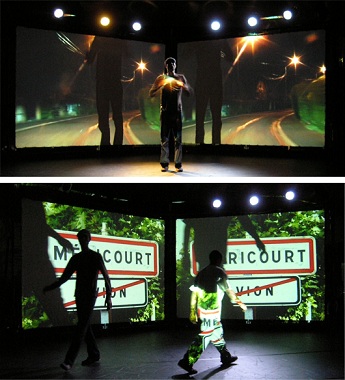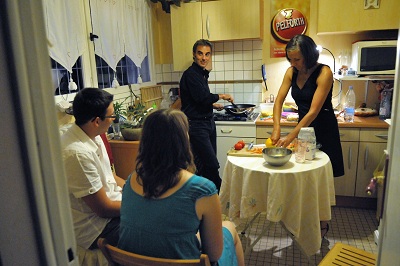THE QUESTION OF THE NEIGHBOURHOOD - APRIL 2010
Neighbours are not just ordinary local people like any others. Sometimes, they are even artists and they decide to investigate the common bond (a neighbourhood, an apartment building or a history) that they share. What can we do with this neighbourhood relationship? Address it, as do the artists and arts players who attended this workshop, and discover the source of issues that go well beyond the boundaries of everyday existence.

â–ºBRIEF SUMMARY

For a humanist relation
Among the countless ways of examining the question of the neighbourhood within the project-spaces represented during this workshop, there are two main categories, both related to time. Either a long-term relationship is established, which implies lasting geographical proximity between the neighbours and an artistic team; or else they are brought together by circumstances, through the realisation of a project. In both cases, the neighbours are central to the concerns of the artists, who find justification for their work and/or the material for their creation. Just as they invite their neighbours to change their point of view on their surroundings, the artists aim to renew the place that they are generally given. In practice, they promote a humanist person-to-person relationship which may manifest itself as part of an artistic production or more simply through various informal occasions of interaction and discussion. According to the geographical area where they live or work, the artists will become attached to a shared history that is sufficiently present to act as a bearing point, such as the mining culture in Loos-en-Gohelle or the working-class culture in Aulnoye-Aymeries. More generally, any action in connection with the neighbourhood is based on a common bond (such as two apartment buildings near the TNT centre, or the redevelopment plan for the neighbourhood where the Gare au Théâtre centre is located) that is the place of intersection of stories and imaginations which the artists aim to make interact.
A political and artistic approach
Encounter is indeed vitally important for artists involved in this type of approach. It is their encounters and interaction with other people that will decide a project (to a certain extent, 232U is the fruit of all encounters that have happened in this area during a period of ten years) and will focus all attention to the point where the production of an artistic work is just one of the many aspects of a relationship. It seems that the question of the neighbourhood then becomes the fundamental question around which everything else revolves. In other words, it is the relationship between people brought together within one same place which is brought into play by the artists. Who do I live next door to? In what way(s)? What do I share with my neighbours? What image do I have of them and vice versa? While the issues involved in these actions are ethical and political, the artists are no less attached to the artistic dimension. It is even because there is “work with the local people†that their work is distinct from work done by other players on the ground, particularly in social affairs. They are all the more attached because their supervising authorities may possibly always confuse these actions with each other and not grasp the singularity of their approach. But the artistic creation is of a kind other than an academic form, and it deserves to be appreciated according to criteria that are not exclusively aesthetic.

Acting on sensitive ground
The originality claimed by artists does not mean that they aim to work on the fringes or outside of the social fabric that unites a geographical area. On the contrary, they try to adapt to its specific features, sometimes to the extent where they risk being at fault. For example, when intermediary partners (local associations) appropriate their project to the point where they distort its intentions; or when, because they are not exempt from certain errors, they themselves lose sight of the realities faced by their neighbours and they make them subject to their artistic concerns. The role of mediation is to prevent any face-to-face confrontation between artists and neighbours that would lead to more compartmentation, whereas the aim is to reduce its harmful effects.
Sebastien Gazeau
Texts written on the basis of discussions in Aulnoy-Aimerie the 25th april 2010 during the workshop on “La question de voisinage†[the question of the neighbourhoud]
Quentin Dulieu
Coordinator of Discussion Workshops



